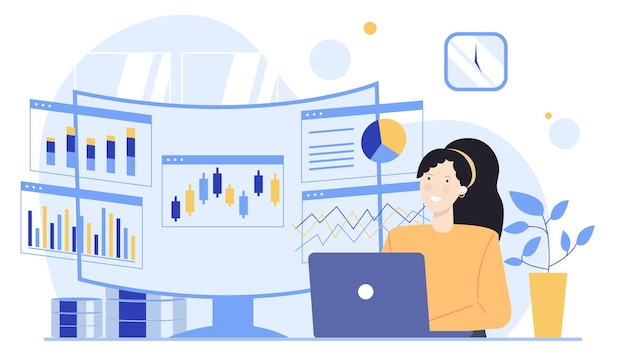Is your data just a mountain of numbers waiting to be understood?
In today’s data-driven era, businesses are craving clarity— and Python data analytics can provide just that.
From simple data manipulation to sophisticated visualizations, Python equips you with the tools needed to transform raw data into actionable insights.
In this article, we’ll explore how leveraging Python’s powerful libraries can unlock insightful business solutions that pave the way for smarter decisions and growth. Get ready to delve into the world of Python data analytics and uncover the game-changing potential it holds for your organization.
Python Data Analytics Overview
Python jest szeroko stosowany w analizie danych dzięki swojej prostocie oraz dostępności potężnych bibliotek. Kluczowe etapy procesu analizy danych obejmują:
- Zbieranie danych
- Czyszczenie danych
- Eksploracja danych
- Wizualizacja danych
Te etapy można skutecznie realizować przy użyciu Pythona.
Wśród najpopularniejszych bibliotek znajdują się:
-
Pandas: Umożliwia manipulację danymi w sposób strukturalny, co jest niezbędne do importowania plików CSV, tworzenia ram danych i przygotowywania danych do analizy.
-
NumPy: Zapewnia wsparcie dla obliczeń numerycznych, pozwalając na wykonywanie skomplikowanych obliczeń na dużych zbiorach danych.
-
Matplotlib: Służy do wizualizacji danych, umożliwiając tworzenie różnorodnych wykresów i diagramów, co pomaga w wizualnym przedstawieniu wyników analizy.
-
SciPy: Zawiera moduły wspierające analizy matematyczne i statystyczne, co zwiększa możliwości analityczne Pythona.
Python jako język programowania jest uważany za idealny do analizy danych, co sprawia, że jest to cenny zestaw umiejętności dla analityków i naukowców zajmujących się danymi.
W skrócie, Python jest kluczowym narzędziem w analizie danych ze względu na swoje potężne biblioteki i efektywność w realizacji złożonych zadań analitycznych.
Key Python Libraries for Data Analytics
W analizie danych w Pythonie kluczowe są trzy podstawowe biblioteki: Pandas, NumPy oraz Matplotlib. Każda z tych bibliotek odgrywa istotną rolę, oferując różne funkcjonalności, które ułatwiają proces analizy.
Pandas to fundamentalna biblioteka do manipulacji danymi. Dzięki niej można efektywnie zarządzać danymi tabelarycznymi i przeprowadzać operacje na dużych zbiorach danych. Pandas oferuje struktury danych takie jak Series oraz DataFrame, które umożliwiają łatwe filtrowanie, sortowanie oraz grupowanie danych, co jest kluczowe w czyszczeniu danych przed ich dalszą analizą.
NumPy, z kolei, jest niezbędny dla pracy z danymi numerycznymi. Oferuje wysokowydajne obiekty tablicowe, które pozwalają na wykonywanie operacji matematycznych i statystycznych na dużych zbiorach danych. NumPy obsługuje również mechanizm zwany broadcasting, który umożliwia wykonywanie operacji arytmetycznych na tablicach o różnych wymiarach, co znacznie przyspiesza proces analizy.
Matplotlib jest kluczową biblioteką do wizualizacji danych. Umożliwia tworzenie różnorodnych wykresów, takich jak wykresy słupkowe, histogramy czy wykresy rozrzutu. Matplotlib ułatwia graficzne przedstawienie wyników analizy, co pozwala na lepsze zrozumienie danych oraz identyfikację wzorców.
Wszystkie te biblioteki są nie tylko popularne, ale również niezbędne w procesie analizy danych. Umożliwiają one agregację, transformację oraz wizualizację danych, co sprawia, że Python stał się jedną z najpopularniejszych platform do analizy danych.
Data Cleaning Techniques in Python for Analytics
Data cleaning in Python is essential for preparing datasets for meaningful analysis. This process involves various techniques designed to enhance data quality and reliability.
One of the most common issues in datasets is the presence of missing values. Python’s Pandas library offers several methods to handle these gaps. The fillna() function allows users to fill missing values with methods such as forward filling or using a specific value. Conversely, rows with missing values can be removed using dropna(), which may be necessary when missing data is extensive.
Removing duplicates is another critical step in data cleaning. The drop_duplicates() function in Pandas efficiently identifies and eliminates duplicate entries based on specified columns, ensuring the dataset’s uniqueness.
Data transformation is also crucial for effective data preprocessing in Python. This includes changing data formats (e.g., converting string dates to datetime objects) and normalizing values (e.g., scaling numerical values). Functions like astype() can effectively change data types and enhance compatibility during analysis.
Additionally, outlier detection is significant in exploratory data analysis. Identifying outliers aids in enhancing the dataset’s overall integrity. The quantile() function can help in setting thresholds for outlier identification, while functions from libraries like NumPy can assist in statistical calculations.
These techniques underscore the importance of data cleaning in Python, ensuring that datasets are accurate and consistent for subsequent analysis steps.
Data Visualization in Python
Data visualization in Python is a crucial component of data analysis, enabling analysts to uncover patterns and insights within datasets. Various libraries provide distinct functionalities for visual representation.
Matplotlib is the foundational library for creating static plots. Its flexibility allows users to generate a wide range of visualizations, from simple line graphs to complex multi-dimensional charts. The API is straightforward, making it a popular choice for beginners.
Seaborn builds on top of Matplotlib, offering enhanced statistical graphics. It simplifies the creation of informative and attractive visualizations. Seaborn supports various complex visualizations, such as heatmaps, violin plots, and pair plots, which help in understanding distributions and relationships in the data.
A notable feature of Seaborn is its ability to handle categorical data gracefully. By using color, style, and size, Seaborn can represent multiple dimensions in a single plot. This allows analysts to present data in a more compelling manner, fostering effective data storytelling.
For interactive visualizations, Plotly stands out. It enables users to create web-based visualizations that are interactive and responsive. Users can zoom in, hover over data points for information, and switch between different visual representation modes. Plotly is especially useful in presentations where user engagement is essential.
Here’s a brief comparison of these libraries:
| Library | Type | Features |
|---|---|---|
| Matplotlib | Static | Flexible, comprehensive plots, basic visualizations |
| Seaborn | Statistical | Enhanced aesthetics, support for complex data relationships |
| Plotly | Interactive | Responsive, user-engaging, web-based visualizations |
The choice of library depends on the visualization requirements. By leveraging these tools effectively, data analysts can communicate findings more clearly and impactfully.
Performing Exploratory Data Analysis (EDA) with Python
Wykonywanie eksploracyjnej analizy danych (EDA) przy użyciu Pythona to kluczowy krok w procesie analizy danych.
Techniki EDA obejmują wizualne i statystyczne badanie zbiorów danych, aby odkryć leżące u podstaw wzorce i relacje.
Istotne metody, które można wykorzystać, obejmują:
-
Tworzenie wykresów rozkładu: Użyj bibliotek takich jak Matplotlib i Seaborn do wizualizacji rozkładów danych. Histogramy i wykresy gęstości pomagają zrozumieć, jak dane są rozłożone.
-
Sprawdzanie wartości odstających: Można wykorzystać wykresy pudełkowe do identyfikacji wartości odstających. Analiza tych wartości jest kluczowa, ponieważ mogą one zniekształcać wyniki.
-
Podsumowywanie statystyk: Funkcje Pandas, takie jak
describe(), dostarczają metryk opartych na podstawowych statystykach, takich jak średnia, mediana i odchylenie standardowe, co pozwala na szybkie zrozumienie danych.
Dzięki tym technikom, analitycy mogą efektywnie identyfikować zależności między zmiennymi i prowadzić bardziej szczegółowe analizy statystyczne.
Przykładowy kod do generowania wykresu rozkładu oraz sprawdzania wartości odstających:
import pandas as pd
import seaborn as sns
import matplotlib.pyplot as plt
data = pd.read_csv('your_dataset.csv')
# Histogram rozkładu
sns.histplot(data['column_name'])
plt.show()
# Wykres pudełkowy dla wartości odstających
sns.boxplot(x=data['column_name'])
plt.show()
Podejmowanie kroków w EDA przy użyciu Pythona pozwala na efektywne i wizualne odkrywanie wzorców, co jest niezbędne dla dalszej analizy danych.
Real-World Applications of Python Data Analytics
Python data analytics is widely utilized across various industries, showcasing its adaptability and effectiveness.
In finance, it can facilitate risk assessment and fraud detection. By implementing predictive analytics, financial institutions can analyze transaction patterns to identify anomalies, preventing potential fraud. Data analytics projects in the financial sector often leverage libraries like Pandas and NumPy for extensive data manipulation.
Healthcare is another sector where Python data analytics has made a significant impact. Analyzing patient data allows for improved treatment plans and operational efficiency. For example, hospitals can use data analytics to track patient outcomes and optimize resource allocation. Machine learning techniques, such as those available in SciPy, can enhance predictive modeling in patient care.
In marketing, customer segmentation is a common application, allowing businesses to target specific demographics effectively. By analyzing consumer behavior data, companies can create tailored marketing strategies that yield better engagement and conversion rates. Visualization libraries like Matplotlib help in presenting these insights clearly, making it easier for stakeholders to make informed decisions.
Moreover, sales analysis leveraging Python can provide actionable insights into trends and performance. Businesses can examine historical sales data to predict future sales, optimizing inventory and supply chain processes. Techniques like regression analysis often yield valuable insights in this context.
Here’s a summary of key applications:
| Industry | Application | Techniques Used |
|————–|——————————|————————|
| Finance | Risk assessment & fraud detection | Predictive analytics, transaction analysis |
| Healthcare | Patient outcome analysis | Machine learning, data visualization |
| Marketing | Customer segmentation | Behavior analysis, targeted marketing |
| Sales | Sales forecasting | Regression analysis, trend analysis |
These real-world applications confirm Python’s role as a crucial tool in data analytics, improving decision-making across industries and fostering innovation.
Python data analytics offers a powerful approach to data interpretation and decision-making.
From understanding the core libraries such as Pandas and NumPy to exploring visualization tools like Matplotlib and Seaborn,
each aspect plays a critical role in transforming raw data into actionable insights.
Utilizing Python for data analytics not only streamlines processes but also enhances data-driven strategies across various industries.
Embracing these techniques propels us toward informed decisions and greater opportunities.
With the continuous growth of Python in the realm of data analytics, the possibilities are truly limitless.
FAQ
Q: What is data analysis with Python?
A: Data analysis with Python involves collecting, transforming, and organizing data to make predictions and informed decisions through specified steps like data preparation, cleaning, and reporting.
Q: Which libraries are essential for data analysis in Python?
A: Essential libraries for data analysis in Python include Pandas for structured data operations, NumPy for numerical computations, and Matplotlib for data visualization.
Q: How does NumPy facilitate data manipulation?
A: NumPy provides high-performance multidimensional arrays and supports operations like indexing, slicing, and broadcasting, making numerical computations efficient.
Q: What can I do with Pandas in data analysis?
A: Pandas enables you to create Series and DataFrames, filter, sort, group, and manipulate data seamlessly from various sources such as CSV and SQL databases.
Q: How do I visualize data in Python?
A: Data visualization in Python can be done using Matplotlib, which offers various plotting functions, including bar charts, histograms, scatter plots, and box plots.
Q: What is Exploratory Data Analysis (EDA)?
A: EDA is a technique that employs visual methods to analyze data, identify patterns, and summarize statistics, focusing on aspects like missing values and correlations.
Q: Why is outlier detection important in data analysis?
A: Outlier detection is crucial as it helps maintain the accuracy of analysis by identifying and removing anomalies that can skew results significantly.
Q: How can I start a data analysis project in Python?
A: You can start by selecting a project idea, like analyzing weather or sales data, then apply relevant Python libraries to collect, clean, and visualize your dataset.
Q: Are there specific tools that can enhance Python data analytics?
A: Yes, Jupyter Notebook provides an interactive coding environment, while IDEs like PyCharm and Visual Studio Code enhance coding efficiency for Python data analytics.
Q: What are some practical applications of Python in data analytics?
A: Python is applied across various industries for tasks like data cleaning, visualization, and statistical analysis, making it a valuable skill for data analysts.


